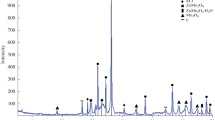Summary
It is possible to extract rare earth compounds out of used nickel-metal-hydride batteries by a hydrometallurgical treatment. During this process a high amount of spent acid which still contains various valuable metals is produced. produced. To remove metals from an aqueous solution many different ways such as electrolysis, precipitation, crystallisation, hydrogen reduction or solvent-extraction are applicable. The regeneration of spent acid makes also sense in order to use it again for the leaching of spent batteries. At industrial scale almost all hydrometallurgical processes are used for the extraction of nickel and cobalt out of aqueous solutions. Experiments for the selective cathodic deposition of nickel and cobalt did not achieve satisfactory results, because the solid showed a layered structure with included impurities. At the precipitation of nickel and cobalt in form of sulphides only a small portion of the theoretical performance was achieved, which was existent in form of a fine precipitate and contained a large amount of impurities. Further experiments for the selective separation of valuable metals from the residual solution by solvent extraction are the next step in the development of a closed recycling concept.
Zusammenfassung
Aus Nickelmetallhydrid-Akkumulatoren können Verbindungen, welche Seltene Erden enthalten, auf hydrometallurgischem Wege gewonnen werden. Dabei entsteht eine große Menge an Restlösung, welche noch eine Vielzahl an Wertmetallen enthält. Die Metallgewinnung aus wässrigen Lösungen kann mit unterschiedlichsten Methoden erfolgen, wie beispielsweise Elektrolyse, Fällung, Kristallisation, Wasserstoffreduktion oder Solvent-Extraktion. Ebenfalls sinnvoll ist es, die dabei entstehende Säure zu regenerieren und wieder für die Laugung von Alt-Akkumulatoren zu nutzen. Großtechnisch wird für die Nickel- und Cobaltgewinnung aus wässrigen Lösungen eine Kombination aus fast allen hydrometallurgischen Verfahren verwendet. Bei Versuchen zur selektiven, kathodischen Abscheidung von Nickel bzw. Cobalt konnten keine zufriedenstellenden Ergebnisse erzielt werden, da der gewonnene Feststoff eine schichtartige Struktur aufwies und Verunreinigungen miteingeschlossen wurden. Bei der Fällung von Nickel und Cobalt in Form von Sulfiden ließ sich nur ein sehr geringer Teil des theoretischen Ausbringens erreichen, welcher zudem in Form eines feinen Niederschlags vorlag, welcher nach Filtration und Trocknung eine große Menge an Verunreinigungen enthielt. Weitere Versuche zur selektiven Trennung der Wertmetalle aus der Restlösung mittels Solvent-Extraktion sind der nächste Schritt zur Entwicklung eines Recyclingkonzeptes mit einem geschlossenen Lösungsmittelkreislauf.
Similar content being viewed by others
Literaturverzeichnis
de Guibert, A.: Critical materials and alternative for storage batteries. http://energy.gov/sites/prod/files/Session_B6_Anne_de_Guibert.ppt, (20.11.2011)
Pillot, C.: The Portable Rechargeable Battery (PRB) market in Europe (2008–2015), http://www.rechargebatteries.org/Portable_Rechargeable_Battery_Market_in_Europe__2008-2015_-_Jan_2011.pdf, (22.11.2011)
European Parliament, Council (2006): Directive 2006/66/EC of the European Parliament and of the Council of 6 September 2006 on batteries and accumulators and waste batteries and accumulators and repealing Directive 91/157/EEC
European Parliament, Council (2008): Directive 2008/12/EC of the European Parliament and of the Council of 11 March 2008 amending Directive 2006/66/EC on batteries and accumulators and waste batteries and accumulators, as regards the implementing powers conferred on the Commission
Bundesministerium für Land- und Forstwirtschaft, Umwelt und Wasserwirtschaft (2008): Verordnung des Bundesministers für Land- und Forstwirtschaft, Umwelt und Wasserwirtschaft über die Abfallvermeidung, Sammlung und Behandlung von Altbatterien und -akkumulatoren (Batterienverordnung) https://www.ris.bka.gv.at/Dokumente/BgblAuth/BGBLA_2008_II_159/BGBLA_2008_II_159.pdf, (16.11.2011)
Kaindl, M., S. Luidold, H. Antrekowitsch: Extraction of rare earths from used nickel metal hydride batteries, In: Proceedings of EMC 2011, Volume 4 (2011), Harre, J.; Waschki, U. (Hrsg.), pp. 1401–1415
Luidold, S., H. Antrekowitsch: Rückgewinnung von Seltenen Erden aus Nickelmetallhydrid-Akkumulatoren, In: DepoTech 2010, (2010) Lorber, K. E. et al. (Hrsg.), S. 301–306
Luidold, S., H. Antrekowitsch: Wasserstoff – ein Reduktionsmittel mit Zukunft: Teil 1 – Stand der Technik, In: BHM Berg- und Hüttenmännische Monatshefte, Volume 152, Issue 9 (2007), Springer Wien, S. 292–295
Luidold, S., H. Antrekowitsch: Wasserstoff – ein Reduktionsmittel mit Zukunft Teil 3: Neue Entwicklungen bei der Wasserstoffreduktion, In: BHM Berg- und Hüttenmännische Monatshefte, Volume 154, Issue 7 (2009), Springer Wien, S. 309–313
Pawlek, F.: Metallhüttenkunde, (1983), de Gruyter Verlag, S. 43–94; S. 786–841
Gock, E., V. Vogt, J. Kähler: Rohstoffaufbereitung, In: Winnacker/Küchler, Chemische Technik: Prozesse und Produkte (2006), WILEYVCH Verlag Weinheim, S. 69–202
Soldenhoff, K.; Hayward, N.; Wilkins, D.: Direct Solvent Extraction of Cobalt and Nickel from Laterite-Acid Pressure Leach Liquors, EPD Congress (1998), The Minerals, Metals & Materials Society, pp. 153–165
Gösele, W., et al.: Feststoffbildung durch Fällung und Kristallisation, In: Chem. Ing. Tech. 62, Issue 7 (1990), WILEY-VCH Verlag Weinheim, S. 544–552
Schatt, W., K.-P. Wieters, B. Kieback: Pulvermetallurgie – Technologie und Werkstoffe, (2007), S. 5–48
Ahn, J.-G., H. T. Hai, D.-J. Kim, J.-S. Park, S.-B. Kim: Direct synthesis of nickel powders from NiO slurry by hydrothermal hydrogen reduction process, Hydrometallurgy, Volume 102, Issues 1–4 (2010), pp. 101–104
Yu, K., H. Liang: Attempt at preparing Cu by direct hydrogen reduction of Cu2S slurry, Materials Letters, Volume 58, Issue 24 (2004), pp. 3045–3048
Queneau, P. E.: Nickel, In: Ullmanns Encyklopädie der technischen Chemie, Band 17 (1979), Verlag Chemie Weinheim New York, S. 239–286
Lossin, A.: Kupfer und Nickel, In: Winnacker/Küchler. Chemische Technik: Prozesse und Produkte (2006), WILEY-VCH Verlag Weinheim, S. 609–668
Kobalt, In: Ullmanns Encyklopädie der technischen Chemie, Band 14 (1977), Verlag Chemie Weinheim New York, S. 269–286
Roine, A., et al.: HSC Chemistry v. 7.14. Pori, Finnland: Outotec Research Oy 2011
Author information
Authors and Affiliations
Corresponding author
Rights and permissions
About this article
Cite this article
Kaindl, M., Luidold, S. & Poscher, A. Recycling von Seltene Erden aus Nickel-Metallhydrid-Akkumulatoren unter besonderer Berücksichtigung von Säurerückgewinnung. Berg Huettenmaenn Monatsh 157, 20–26 (2012). https://doi.org/10.1007/s00501-012-0053-4
Received:
Accepted:
Issue Date:
DOI: https://doi.org/10.1007/s00501-012-0053-4




